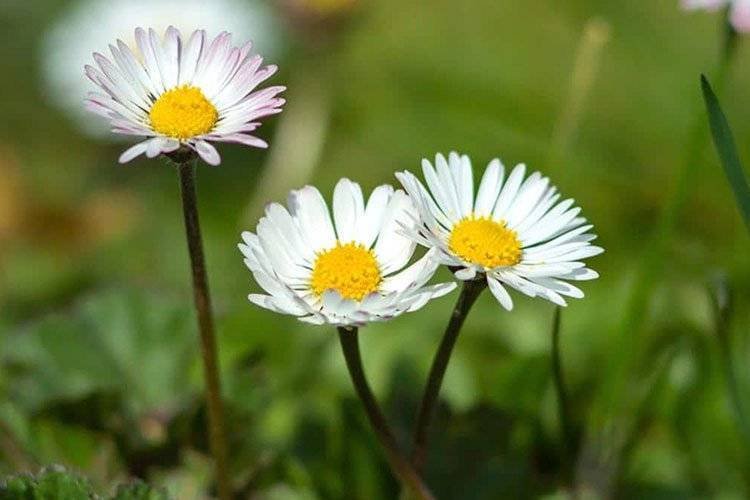Beautiful Plants For Your Interior

Common Bellis Perennis Daisy
Quick Weed Facts:
Shape: The Common Bellis Perennis Daisy has a small rosette of thin white petals (sometimes tinged pink) surrounding a bright yellow centre. The rosette is supported on a single stem.
Colour: White/Yellow
Family: Asteraceae Genus: Bellis
Main Species: Common Daisy (Bellis perennis)
Other Names: Lawn Daisy, Common Daisy, Mary’s Rose, Bruisewort
Most Active Growing: April through to September
Weed Type: Perennial
The Common Daisy Bellis Perrennis is a common lawn weed and is a native European plant, but has spread as far afield as Asia and North America. Interestingly Bellis seems to come from bellus, Latin for “pretty”, and perennis is Latin for “everlasting”. Which sums up this plant in more ways than one.
However, this small white and yellow ‘rossetted flower’ is often the bain of lawn keepers everywhere, who want to rid their lawns of daisies and should not be confused with the now popular ‘Bellis Daisy’. This daisy is, botanically bred from Bellis Perennis the ‘wild daisies’ and used to fill garden beds, rock gardens, patio pots etc….
Our common Bellis perennis daisy has leaves that are small, very dark green which are rounded to ‘spoon shaped’ in looks. Measuring ¾ – 2’in (2-5 cm) long. They grow from a central rosette on a ‘single’ hairy stalk, bearing a small ‘rosette’ of thin white petals, which surrounds a bright yellow centre. Often the white petals are ‘tinged’ with pink.

Common Bellis Perennis Daisy Grow On a Single Hairy Stalk And Often The Petals Are ‘Tinged’ Pink
Common Bellis Perennis Daisy Control – Naturally
The common daisy (Bellis perennis) spreads via short underground ‘runners’ called rhizomes. Eventually, a low-growing, dense mat forms that tolerate regular and close mowing. Be careful though, as once established, they will out-compete and smother fine lawn areas.
N.B Removal of the Bellis Perennis Daisy both chemically and naturally and lots more information on this tiny little plant, is covered in our post How to Remove Daisies From a Lawn
FAQs
Is Bellis Perennis Safe For Dogs?
Animals are at risk of getting sick if they chew on daisies (Bellis perennis and Anthemis cotula). When daisies are consumed raw, animals may develop contact dermatitis, vomit, have diarrhoea, become anorexic, or experience allergic reactions or prolonged bleeding.
Are Daisies Poisonous To Humans?
Chrysanthemums (daisies) are toxic to children, and it is said they may cause skin rashes, blisters, and other issues.
What Are The Health Benefits Of Bellis Daisies?
It is reported that wild daisy tea may be used to treat coughs, bronchitis, liver and kidney disorders, and inflammation (swelling).
It may also be used as a drying agent (astringent) or as a ‘blood purifier.’ Some people use homoeopathic wild daisies in order to prevent problems during childbirth, pain and bleeding, and minor bleeding
Conclusion
We have added a little more information on this page about the Common Bellis Perennis Daisy. However, the majority of information is found in our post about the removal of daisies from your lawn. Please follow the link as shown above.
If you find this page useful, don’t forget to visit our FAQ page for more gardening tips, tricks and information on a whole host of subjects for the home and garden.
Disclaimer: The contents of this article are for educational and gardening purposes only. Before using or ingesting ANY herb or plant for medicinal purposes or otherwise, please consult a physician, medical herbalist or other suitable professionals for advice.
Return to Garden Weeds
